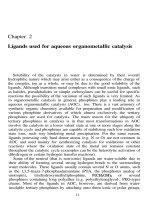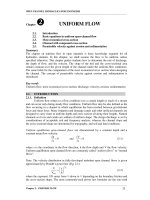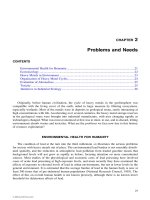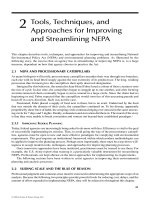Chapter 2 accounting for partnerships
Bạn đang xem bản rút gọn của tài liệu. Xem và tải ngay bản đầy đủ của tài liệu tại đây (448.62 KB, 102 trang )
Chapter 2
Accounting for Partnerships:
Organization and Operation
All examples are from
textbook by Larsen
ACCT 501
Objectives of the Chapter
To learn the accounting and reporting for
limited liability partnerships (LLPs) including:
a. the organization,
b. the income-sharing plans,
c. the financial statements, and
d. the changes in ownership.
■ To learn the accounting for limited
partnerships
■
Partnerships: Organization and Operation
2
Partnerships
■
The Uniform Partnership Act defines a
partnership as: "an association of two or more
persons to carry on, as co-owners, a business
for profit".
■
Partnerships generally are associated with the
practice of law, medicine, public accounting and
other professions, and also with small business
enterprises.
Partnerships: Organization and Operation
3
Partnerships (contd.)
■
■
General partnership: in which all partners have
unlimited personal liability for debts of the
partnership.
Limited liability partnerships (LLPs): individual
partners of LLPs are personally responsible for
their own actions and for the actions of
employees under their supervision.
Partnerships: Organization and Operation
4
Partnerships (contd.)
■
■
The LLPs as a whole, like a general partnership,
is responsible for the actions of all partners and
employees.
Since the LLPs are the prevalent form of
partnerships and the issues of organization,
income-sharing plans and changes in ownership
of LLPs are similar to those of general
partnerships, LLPs are discussed in this chapter.
Partnerships: Organization and Operation
5
Organization of a Limited Liability
Partnership (LLP)
Basic Characteristics of the LLP:
1.
Ease of Formation.
2.
Limited Life.
3.
Mutual Agency.
4.
Co-Ownership of Partnership Assets and
Earnings.
Partnerships: Organization and Operation
6
Major Differences between an LLP
and a Corporation
Characteristics of a corporation:
1. Separated legal entity from its owners: it can
buy, sell and own properties.
2. Limited liability for stockholders.
3. Continuous existence.
4. Ease of transfer of ownership.
5. Ease of capital generation.
Partnerships: Organization and Operation
7
Major Differences between an LLP
and a Corporation (contd.)
6. Centralized authority and responsibility-- to the
President, not to numerous owners.
7. Professional management
8. Corporation taxes (double taxation).
9. Separation of ownership and management:
principal & agent conflicts.
10. Government regulations.
Partnerships: Organization and Operation
8
Taxation of LLP
■
■
An LLP pays no income tax.
LLP is only required to file an annual information
return showing its revenue and expenses, the
amount of its net income and the division of the
net income among the partners.
Partnerships: Organization and Operation
9
Taxation of LLP
■
The partners of LLP report their shares of the
ordinary net income from the partnership and
dividends and charitable contributions in their
individual income tax returns, regardless of
whether they received more of less than this
amount of cash from the LLP.
Partnerships: Organization and Operation
10
Is the LLP a Separate Entity ?
■
■
Legal status: a partnership is an "association of
persons" and is not a separate entity while a
corporation is a separate entity from its owners.
Economic substance: in terms of managerial
policy and business objectives, LLPs are as
much business and accounting entities as are
corporations.
Partnerships: Organization and Operation
11
Is the LLP a Separate Entity ?
(contd).
■
■
LLPs typically are guided by long-range plans
not likely to be affected by the admission or
departure of a single partner.
The accounting policies of LLPs should reflect
the fact that the partnership is an accounting
entity apart from its owners.
Partnerships: Organization and Operation
12
The Partnership Contract
■
■
A good business practice requires the
partnership contract in writing.
The followings are a few important points to
be covered in a written contract for a LLP:
Partnerships: Organization and Operation
13
The Partnership Contract (contd.)
1.
2.
The formation date and the planned duration of
the partnership; the names of the partners, and
the name and business activities of the
partnership.
The assets to be invested by each partner, the
procedure for valuing noncash investments,
and the penalties for a partner's failure to
invest and maintain the agreed amount of
capital.
Partnerships: Organization and Operation
14
The Partnership Contract (contd.)
3.
4.
5.
The authority, the rights and the duties of each
partner.
The accounting period to be used, the nature of
accounting records, financial statements and
audits by independent public accountants.
The net income (loss) sharing plans.
Partnerships: Organization and Operation
15
The Partnership Contract (contd.)
6.
The drawings allowed to each partner.
7.
Insurance on the lives of partners
8.
Provision for arbitration of disputes.
9.
Provision for liquidation of the partnership at
the end of the term specified in the contract or
at the death or retirement of a partner.
Partnerships: Organization and Operation
16
Ledger Accounts for Partners
■
1.
2.
3.
The following three types of accounts are
used in LLPs for each partner:
Capital accounts.
Drawing accounts.
Accounts for loans to and from partners.
Partnerships: Organization and Operation
17
Ledger Accounts for Partners (contd.)
■
The original investment from partner is recorded as:
Assets (based on current
$$$
Liabilities
$$$
Capital-Partner A $$$
fair value)
■
Drawings from Partners are recorded as:
Partner A
$$$
$$$
Drawing –
Cash
Partnerships: Organization and Operation
18
Ledger Accounts for Partners (contd.)
At the end of each accounting period, the
income summary ledger account is transferred
to the capital accounts in accordance with
income sharing plan specified in the contract.
■
Also, the debit balances in the drawing accounts
are closed to the partner's capital account.
■
Partnerships: Organization and Operation
19
Ledger Accounts for Partners (contd.)
Loans Receivable from Partners: this account
is debited when a partner receives cash from
the LLP with the intention to repay this amount.
■
Loans Payable to Partners: this account is
credited when a partner makes a cash payment
to the LLP that is considered a loan rather than
an investment.
■
Partnerships: Organization and Operation
20
Ledger Accounts for Partners (contd.)
If a substantial unsecured loan has been made
to a partner and repayment appears doubtful, it
is appropriate to offset the receivable against
the partner's capital account.
■
Partnerships: Organization and Operation
21
Valuation of Investments by Partners
Gains or losses from disposal of noncash
assets invested by the partners is measured as:
■The disposal price – the current fair
value
of the assets when invested adjusted for any
depreciation or amortization to the date of disposal.
■These gains (losses) are divided based on the
income sharing plan of the LLP.
■
Partnerships: Organization and Operation
22
Income-Sharing Plans for LLP
Partners can agree on any type of income sharing
plan regardless of the amount of their respective
capital investment.
■
The Uniform Partnership Act states that if partners
fail to specify a plan for sharing net income/loss, it is
assumed that they intend to share equally.
■
Partnerships: Organization and Operation
23
Income-Sharing Plans for LLP
(contd.)
■
1.
2.
3.
The following are a few possible plans of incomesharing:
Equally.
In the ratio of partners' capital account balance
on a specific date or in the ratio of average capital
account balance in the year.
Allowing interest on partner's capital account
balances and dividing the remaining net
income/loss in a specified ratio.
Partnerships: Organization and Operation
24
Income-Sharing Plans for LLP
(contd.)
4.
5.
6.
Allowing salaries to partners and dividing the
remaining net income/loss in a specified ratio.
Bonus to managing partner based on income.
Allowing salaries to partners, allowing interest on
capital account balances, and dividing the
remaining net income/loss in a specified ratio.
Partnerships: Organization and Operation
25









